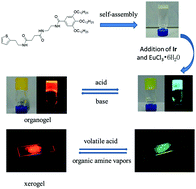A dual response organogel system based on an iridium complex and a Eu(iii) hybrid for volatile acid and organic amine vapors†
Abstract
A thiophene-based hybrid organogel system consisting of complex iridium (Ir) and EuCl3·6H2O was designed and synthesized to realize dual responses to volatile acids and organic amine vapors. The photophysical properties and self-assembly of compound 1 and the hybrid organogel were also studied. Compound 1 could gelate some organic solvents and self-assemble into 3D nanofibers in the gels. The stable hybrid organogel 1-Ir-Eu could be obtained after addition of complex Ir and EuCl3·6H2O. FTIR spectral results showed that the hydrogen bond still remained even upon addition of complex Ir, EuCl3·6H2O, NaOH and CF3COOH to organogel 1. Interestingly, the emission properties of the hybrid organogel 1-Ir-Eu could undergo interconversion between cyan light and red light via addition of NaOH and CF3COOH. The emission properties of xerogel film 1-Ir-Eu obtained in the presence of NaOH could also undergo fast and reversible transition in response to volatile acids such as CF3COOH, formic acid, acetic acid, propionic acid and organic amine vapors such as ammonium hydroxide, Et3N, tripropylamine, and ethylenediamine. The emission spectral change of Ir-Eu in the organogel or xerogel in the presence of base and acid demonstrated the formation of a new complex between complex Ir and EuCl3·6H2O. This dual-response process could be repeated many times. Contact angle experiment results further showed the morphology and internal components of the xerogel film surface in the process of response to gaseous CF3COOH and Et3N. This work provides a method for producing multifunctional supramolecular materials for sensing volatile acids and organic amine vapors.


 Please wait while we load your content...
Please wait while we load your content...